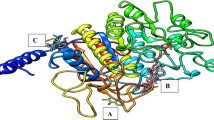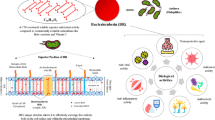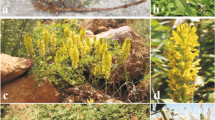Abstract
The aim of the present study was to investigate the antimutagenic effects of chrysin (CR), a flavonoid compound contained in many fruits, vegetables and honey. Earlier investigations with bacterial indicators showed that CR is one of the most potent antimutagens among the flavonoids. In the present study, we tested the compound in the Salmonella strains TA98 and TA100 in combination with benzo(a)pyrene (B(a)P) and 2-amino-1-methyl-6-phenylimidazo[4,5-b]pyridine (PhIP) and found pronounced protective activity over a concentration range between 10 and 100 μg/ml. The compound itself was devoid of mutagenic activity at all concentrations tested. In the micronucleus (MN) assay with human-derived HepG2 cells, a different pattern of activity was seen. CR itself caused significant induction of MN at dose levels ≥15 μg/ml; in combination experiments with B(a)P and PhIP, U-shaped dose-response curves were obtained and protection was found only in a narrow dose range (5 – 10 μg/ml). Our findings indicate that the molecular mechanisms that account for the antimutagenic effects of CR in bacterial cells are different from those responsible for the effects in HepG2 cells. Earlier reports indicate that the antimutagenic effects of CR towards B(a)P and heterocyclic amines in bacterial indicators is due to inhibition of the activity of CYP1A. In contrast to this, we found a significant induction of CYP1A1 activity in HepG2 cells by CR. It can also be excluded that induction of GST, which is involved in the detoxification of polycyclic aromatic hydrocarbons accounts for the protective effects of CR against B(a)P since this enzyme was not significantly induced in the HepG2 cells. In the case of PhIP, induction of UDGPT and/or inhibition of sulfotransferase seen in human derived HepG2 cells after exposure to CR might play a role in the antimutagenic effects. In conclusion, our findings show that data from antimutagenicity studies with bacterial indicators cannot be extrapolated to HepG2 cells, and that CR causes genotoxic effects at higher dose levels in the latter cells. The implications of these observations for human chemoprevention strategies are discussed.






Similar content being viewed by others
References
Aden DP, Vogel A, Plotkin S, Damjanov I, Knowles BB (1979) Controlled synthesis of HBs Ag in a differentiated human liver carcinoma-derived cell line. Nature 282:615–616
Alldrick AJ, Flynn J, Rowland IR (1986) Effects of plant derived flavonoids and polyphenolic acids on the activity of mutagens from cooked food. Mutat Res 163:225–232
Alldrick AJ, Lake BG, Rowland IR (1989) Modification of in vivo heterocyclic amine genotoxicity by dietary flavonoids. Mutagenesis 4:365–370
Beson A, Hunkeler M, Talalay P (1980) Increase of NAD(P)H:quinone reductase by dietary antioxidants: possible role in protection against carcinogenesis and toxicity. Proc Natl Acad Sci 77:5216–5220
Breinholt V, Lauridsen ST, Dragsted LO (1999) Differential effects of dietary flavonoids on drug metabolising and antioxidant enzymes in female rats. Xenobiotica 29:1227–1240
Buening MK, Chang RL, Huang MT,. Fortner GJ, Wood AW, Conney AH (1981) Activation and inhibition of benz(a)pyrene and aflatoxin metabolism in human liver microsomes by naturally occurring flavonoids. Cancer Res 41(1981) 67–72
Choi JS, Park KY, Moon SH, Rhee SH, Young HS (1994) Antimutagenic effect of plant flavonoids in the Salmonella assay system. Arch Phar Res 17:71–75
Conney AH, Buening MK, Pantuck EJ, Pantuck CR, Fortner JG, Anderson KE, Kappas A (1980) Regulation of human drug metabolism by dietary factors. Ciba Found Symp 76:147–167
Darroudi F, Meijers CM, Hadjidekova V, Natarajan AT (1996) Detection of aneugenic and clastogenic potential of X-rays and directly and indirectly acting chemicals in human hepatoma (Hep G2) cells and peripheral blood lymphocytes using the micronucleus assay and in situ fluorescent hybridization with DNA centromeric probe. Mutagenesis 11:425–433
Da Silva J, Hermann SM, Heuser V, Peres W, Posssa Marroni N, Gonzalez-Gallego J, Erdtmann B (2002) Evaluation of the genotoxic effect of rutin and quercetin by comet assay and micronucleus test. Food Chem Toxicol 40:941–947
Eaton EA, Walle KK, Lewis AJ, Hudson T, Wilson AA, Wake T (1996) Flavonoids, potent inhibitors of the human P-form phenolsulfotransferase. Drug Metabol Disp 24:232–237
Ferguson LR (2001) Role of plant polyphenols in genomic stability. Mutat Res 475:89–111
Francis AR, Shetty TK, Bhattacharya RK (1989) Modifying role of dietary factors on the mutagenicity of aflatoxin B1: in vitro effects of plant flavonoids. Mutat Res 222:393–401
Galijatovic A, Otake Y, Walle UK, Walle T (1999) Extensive metabolism of the flavonoid chrysin by human Caco-2 and HepG2 cells. Xenobiotica 29:1241–1250
Galijatovic A, Walle UK, Walle T (2000) Induction of UGT-glucuronosyltransferase by the flavonoids chryin and quercetin. Pharm Res 17:21–26
Grant DM, Lottspeich F, Mayer KA (1989) Evidence for two closely related isozymes of arylamine N-acetyltransferase in human liver. FEBS Lett 244:203–207
Habig WH, Pahst MJ, Jacoby WB (1974) Glutathione S-transferases: The first enzymatic step in mercapturic acid formation. J Biol Chem 249:7130–7139
Hardigree AA, Epler JL (1978) Comparative mutagenesis of plant flavonoids in microbial systems. Mutat Res 58:231–239
Havsteen B (1983) Flavonoids, a class of natural products of high pharmacological potency. Biochem Pharmacol 32:1141–1148
Heo MY, Yuk S, Kim KH, Kim HP, Au W (1992) Anticlastogenic effects of flavonoids against mutagen induced micronuclei in mice. Mutat Res 284:243–249
Hertog MGL, Hollman PCH, Katan MB (1992) Content of potentially anticarcinogenic flavonoids of 28 vegetables and 9 fruits commonly consumed in the Netherlands. J Agri Food Chem 40:2379–2383
Hertog MGL, Hollman PCH, Van der Putre B (1993) Content of potentially anticarcinogenic flavonoids of tea infusions, wines and fruit juices. J Agri Food Chem 41:1242–1246
Huang MT, Wood AW, Newmark HL, Sayer JM, Yagi H, Jerina DM, Conney AH (1983) Inhibition of the mutagenicity of bay region diol epoxides of polycyclic aromatic hydrocarbons by phenolic plant flavonoids. Carcinogenesis 4:1631–1633
Kassie F, Rabot S, Uhl M, Huber W, Qin HM, Helma C, Schulte-Hermann R, Knasmüller S (2002) Chemoprotective effects of garden cress (Lepidium sativum) and its constituents towards 2-amino-3-methyl-imidazo[4,5-f]quinoline (IQ)-induced genotoxic effects and colonic preneoplastic lesions. Carcinogenesis 23:1155–1161
Kassie F, Uhl M, Rabot S, Grasl-Kraupp B, Verkerk R, Kundi M, Chabicovsky M, Schulte-Hermann R, Knasmüller S (2003a) Chemoprevention of 2-amino-3-methylimidazo[4,5-f]quinoline (IQ)-induced colonic and hepatic preneoplastic lesions by cruciferous vegetable juices administered simultaneously with the carcinogen. Carcinogenesis, 24:255–261
Kassie F, Mersch Sundermann V, Edenharder R, Platt KL, Darroudi F, Lhoste E, Humbolt C, Muckel E, Uhl M, Kundi M Knasmüller S (2003b) Development and application of test methods for the detection of dietary constituents which protect against heterocyclic aromatic amines. Mutat Res Mutat Res 523–524, 183–192
Kassie F, Laky B, Gminski R, Mersch-Sundermann V, Scharf G, Lhoste E, Knasmüller S (2003c) Effects of garden and water cress juices and their constituents, benzyl and phenethyl isothiocyanates, towards benzo(a)pyrene-induced DNA damage: a model study with the single cell gel electrophoresis/Hep G2 assay. Chem Biol Interact 142:285–296
King RS, Kadlubar FF, Turesky RJ (2000) In vivo metabolism. In: Nagao M, Sugimura T (eds) Food borne carcinogens. Wiley, New York, pp 90–111
Knasmüller S, Parzefall W, Sanyal R, Ecker S, Schwab C, Uhl M, Mersch-Sundermann V, Williamson G, Hietsch G, Langer T, Darroudi F, Natarajan AT (1998) Use of metabolically competent human hepatoma cells for the detection of mutagens and antimutagens. Mutat Res 402:185–202
Knasmüller S, Steinkellner H, Majer BJ, Nobis EC, Scharf G, Kassie F (2002) Search for dietary antimutagens and anticarcinogens: methodological aspects and extrapolation problems. Food Chem Toxicol 40:1051–1062
Kuhnau, J (1976) The flavonoids: a class of semi-essential food components: their role in human nutrition. World Rev Nutr Diet 24:117–120
Kulling SE, Rosenberg B, Jakobs, E, Metzler M (1999) The phytoestrogens coumoestrol and genistein induce structural chromosomal aberrations in cultured human peripheral blood lymphocytes. Arch Toxicol 73:50–54
Laky BA, Knasmüller S, Gminiski R, Mersch-Sundermann V, Scharf G, Verkerk R, Freywald C, Uhl M, Kassie F (2002) Protective effects of Brussels sprouts towards benzo(a)pyrene-induced DNA damage: a model study with the single cell gel electrophoresis /HepG2 assay. Food Chem Toxicol 40:1077–1083
LeBon AM, Siess MH, Suschetet CM (1992) Inhibition of microsome mediated binding of benzo(a)pyrene to DNA by flavonoids either in vitro or after dietary administration to rats. Chem Biol Interact 83:65–71
Lee H, Wang HW, Su HY, Hao NJ (1994) The structure activity relationships of flavonoids as inhibitors of cytochrome P450 enzymes in rat liver microsomes and the mutagenicity of 2-amino-3-methylimidazo[4,5-f]quinoline. Mutagenesis 9:101–106
Lee H, Yeom H, Kim YG, Yoon CN, Jin C, Choi JS, Kim BR, Kim DH (1998) Structure-related inhibition of human hepatic caffeine N-demethylation by naturally occurring flavonoids. Biochem Pharmacol 55:1369–1375
Long DJ II, Waikel RL, Wang XJ, Perlaky L, Roop DR, Jaiswal AK (2000) NAD(P)H:quinone oxidoreductase 1 deficiency increases susceptbility to benzo(a)pyrene-induced mouse skin carcinogenesis. Cancer Res 60:5913–5915
Lowry OM, Rosebrough NJ, Farr AL, Randall RJ (1951) Protein measurement with the folin phenol reagent. J Biol Chem 193:265–275
Lubet RA, Mayer RT, Cameron JW, Nims RW, Burke MD, Wolff T, Guengerich FP (1985) Dealkylation of pentoxyresorufin: a rapid and sensitive assay for measuring induction of cytochrome(s) P450 by phenobarbital and other xenobiotics in the rat. Arch Biochem Biophys 238:43–48
Lutz WK, Schlatter J (2000) Relative contributions of chemical carcinogens in the diet vs overnutrition. In: Eisenbrand G, Dayan AD, Elias PS, Grunow W, Schlatter J (eds) Carcinogenic and anticarcinogenic factors in food. Wiley-VCH, Weinheim, pp101–107
Marchand LL, Murphey SP, Hankin JH, Wilkens LR, Kolonel LN (2000) Intake of flavonoids and lung cancer. J Natl Cancer Inst 92:154–160
Mersch-Sundermann V, Hölzke H, Polmieri R, Shariti S, Genfer C, Gminiski R (2000) Einsatz humaner metabolisch kompetenter Zellen (HepG2) zur Identifikation mutagener, kanzerogene und antikanzerogene Substanzen in Lebensmitteln. ERNO Z Ernährungsökol 1:11–17
Mohn GR, Van der Stel JJ, Stavenuiter JFC, Hamzink MRJ, Van der Kreijil CF (1996) Mutagenic and antimutagenic activities of flavonoids in the Ames/Salmonella test. RIVM Report No. 659001–004. Natl Inst Publ Health and Environment, Bilthoven, pp 1–32
Muckel E, Frandsen H, Glatt HR (2002) Heterologous expression of human N-acetyltransferases 1 and 2 in Salmonella typhimurium for mutagenicity testing of heterocyclic amines. Food Chem Toxicicol 40:1063–1068
Mukhtar H, Das M, Khan WA, Wang ZY, Bik DP, Bickers DR (1988) Exceptional activity of tannic acid among naturally occurring plant phenolics in protecting against 7,12-dimethylbenz(a)anthracene, benzo(a)pyrene, 3-methylcholanthrene and N-methyl-N-nitrosourea induced skin carcinogenesis in mice. Cancer Res 48:2361–2365
Murata M, Kobayashi M, Kawahishi S (1999) Mechanism of oxidative DNA damage induced by a heterocyclic amine, 2-amino-3,8-dimethylimidazo[4,5-f]quinoline. Jpn J Cancer Res 90:268–275
Ratty AK, Das NP (1988) Effects of flavonoids on nonenzymatic lipid peroxidation: structure-activity relationship. Biochem Med Metab Biol 39: 69–79
Sanyal R, Darroudi F, Parzefall W, Nagao M, Knasmüller S (1997) Inhibition of the genotoxic effects of heterocyclic amines in human derived hepatoma cells by dietary bio-antimutagens. Mutagenesis 12:297–303
Schimmer O, Kluger A, Paulini H, Haefele F (1994) An evaluation of 55 commercial plant extracts in the Ames mutagenicity test. Pharmazie 49:448–451
Schwab CE, Huber WW, Parzefall W, Hietsch G, Kassie F, Schulte Hermann R, Knasmüller S (2000) Search for compounds that inhibit the genotoxic and carcinogenic effects of heterocyclic aromatic amines. Crit Rev Toxicol 30:1-69
Siess MH, Penner A, Gaydou E (1989a) Inhibition of ethoxy- and pentoxyresrufin dealkylase of rat liver by flavones and flavonols: structure activity relationships. Eur J Metab Pharmacol 14:235–239
Siess MH, Gelillermic M, Le Bon AM, Suschetet M (1989b) Induction of monoxygenase and transferase activities in rat by dietary administration of flavonoids. Xenobiotica 19:1379–1386
Siess HM, Lecterc J, Canivenc-Lavier MC, Rat P, Suschetet M (1995) Heterogenous effects of natural flavonoids on monoxygenase activities in human and rat liver microsomes. Toxicol Appl Pharmacol 130:73–78
Siess MH, Le Bon AM, Canivenc-Lavien MC, Amitot MJ, Sahatier S, Aubert SJ, Suschetet M (1996) Flavonoids of honey and propolis: characterisation and effect on hepatic drug metabolising enzymes and benzo(a)pyrene DNA binding in rats. J Agri Food Chem 44:2297–2301
Steinmetz KA, Potter JD (1991) Vegetables, fruits, and cancer. II. Mechanisms. Cancer Causes Control 2:427–442
Uhl M, Helma C, Knasmüller S (1999) Single-cell gel electrophoresis assays with human-derived hepatoma (Hep G2) cells. Mutat Res 441:215–224
Uhl M, Helma C, Knasmüller S (2000) Evaluation of the single cell gel electrophoresis assay with human hepatoma (Hep G2) cells. Mutat Res 468:213–225
Van Borstel RC, Higgins JA (1998) Janus carcinogens and mutagens. Mutat Res 402:321–329
Voogd CE, van der Stel JJ, van Bruchem MC, Stavenuiter JFC (1993) De antimutagene werking van chlorophyllin en hematine op de mutagene werking van benzo(a)pyreen, de voedselcontaminant PhIP en 2-aminoanthraceen op Salmonella typhimurium TA98 en TA100. RIVM rapport nr. 659001 001. National Institute of Publich Health and Environmental Protection, Bilthoven, pp 1.64
Walle T, Otake Y, Galijatovic A, Ritter JK, Walle UK (2000) Induction of UDP-glucuronosyltransferase UGT1A1 by the flavonoid chrysin in the human hepatoma cell line. Drug Metab Dispos 28:1077–1082.
Wattenberg LW, Leong JL (1970) Inhibition of the carcinogenic action of B(a)P by flavones. Cancer Res 30:1922–1925
Watzl B, Leitzmann C (1999) Bioaktive Substanzen in Lebensmitteln. Hippokrates Verlag, Stuttgart
Wood AW, Huany MT, Chang RL, Newmark HL, Lenr RE, Yagi H, Sayer JM, Jerina DM, Conney AH (1982) Inhibition of the mutagenicity of bay region diol epoxides of polycyclic aromatic hydrocarbons by naturally occurring plant phenols: exceptional activity of ellagic acid. Proc Natl Acad Sci 79:5513–5517
Yo D, Berlin JA, Penning TM, Field JA (2002) Reactive oxygen species generated by PAH-O-quinones cause change in function mutations in p53. Chem Res Toxicol 15:832–842
Young WS, Lietman PS (1978) Chloramphenicol glucuronosyltransferase: assay, ontogeny and inducibility. J Pharmacol Exp Ther 204:203–211
Acknowledgements
The experimental work was sponsored by EU grants (HEPANDA and HC-Amines to E.LE and S.K). The authors want to thank S. Garrido, S. Lorry and K. Gloux for their helpful technical assistance.
Author information
Authors and Affiliations
Corresponding author
Rights and permissions
About this article
Cite this article
Uhl, M., Ecker, S., Kassie, F. et al. Effect of chrysin, a flavonoid compound, on the mutagenic activity of 2-amino-1-methyl-6-phenylimidazo[4,5-b]pyridine (PhIP) and benzo(a)pyrene (B(a)P) in bacterial and human hepatoma (HepG2) cells. Arch Toxicol 77, 477–484 (2003). https://doi.org/10.1007/s00204-003-0469-4
Received:
Accepted:
Published:
Issue Date:
DOI: https://doi.org/10.1007/s00204-003-0469-4




